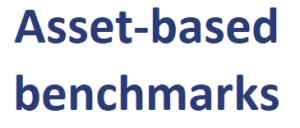Types of asset based benchmarks
Asset based benchmarks are widely used in the financial industry. They are used to assess the performance of active managers. There are at least seven primary types of benchmarks that are used:
- absolute benchmarks
- broad market benchmarks
- style indices
- factor-model based benchmarks
- return-based benchmarks
- manager universes
- custom security-based benchmarks
On this page, we discuss the main characteristics of each type of benchmark.

Absolute benchmarks
Absolute benchmarks are objective benchmarks that aim to exceed a minimum target return. An example would be the minimum acceptable return (MAR) that is used to compute the Sortino ratio. The advantage is that it is simple, the disadvantage is that it is not an investable benchmark.
Broad market benchmarks
These are based on well-known broad market indexes that are used as benchmarks (e.g. the Euro Stoxx). The advantage is that they are well-recognized, investable, unambiguous, measurable, and appropriate to use if it reflects the current investment process of the manager. The disadvantage is that the style of the manager may deviate from the style reflected in the index.
Style indices
Style indices represent specific portions of an asset category. Well-known style indices include large-cap growth, large-cap value, small-cap growth and small-cap value. The advantages are that they are widely available, widely understood, and may fit the manager’s style if he or she is indeed targeting those portions of the asset category.
Factor-model based benchmarks
Factor models relate a specific set of factor exposures to the returns on an account. The CAPM model is an example of a single-factor model. The advantage of factor models is that they are useful in performance evaluation, providing insight into the manager’s style. The disadvantage is that they may not be intuitive to all managers or sponsors, require a lot of data, may be misspecified.
Manager universes
This method is used if there are no other benchmarks available. Very often, the median manager of managers that follow the same style is used as a benchmark. The advantage is that it is observable and thus measurable. The disadvantage is that the universe may be subject to survivorship bias, that the universe is accurate, and that the benchmark is not investable since we only know ex-post the median manager.
Custom security-based benchmarks
Finally, we have custom benchmarks that are designed to reflect the manager’s security allocations and investment process. The advantage is that this is the best kind of benchmark we can imagine using. It also allows for continual monitoring and it allows fund sponsors to effectively allocate risk. The disadvantage is that it is expensive to create and maintain. Also, it may be impossible to construct if the manager is not willing to disclose the full process.
Summary asset based benchmarks
We discussed seven types of asst-based benchmarks. Each has their advantages and disadvantages and some may simply not be available for some kinds of investments.
